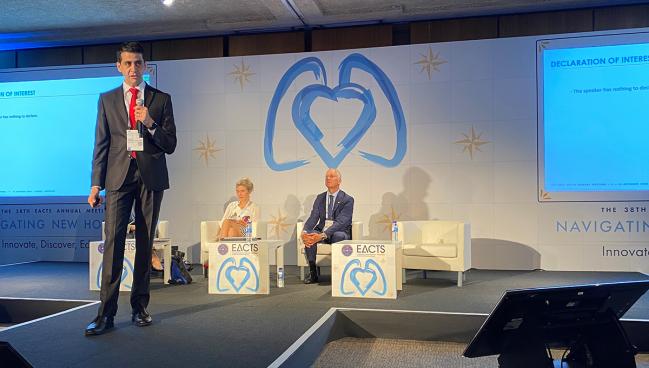Enhanced Recovery After Cardiac Surgery: Fewer Complications, Shorter Stays
A Swiss center’s experience makes it clear that ERAS protocols make a difference following cardiac surgery, new research shows.

LISBON, Portugal—Enhanced recovery after surgery (ERAS) in patients undergoing elective cardiac surgery has increased freedom from postsurgical complications by 18% over 1 year, according to a Swiss center’s experience. The protocols, which include extra patient education, infection prevention, nonopioid pain management, and early mobilization, also led to a 2-day reduction in hospital length of stay.
Developed to improve care and reduce postsurgical costs and complications, ERAS practices have been used across various surgical fields for the past two decades, but the approach was only formally adopted by cardiac surgeons in 2018. While protocols can vary by institution, research has shown that ERAS is associated with safe hospital discharge of patients as early as 3 days after cardiac surgery without worrisome increases in readmission, morbidity, or mortality.
Mario Verdugo-Marchese, MD (Lausanne University Hospital CHUV, Switzerland), who presented the findings at the European Association for Cardio-Thoracic Surgery 2024 meeting, told TCTMD they should encourage other centers to adopt formal protocols proven to enhance recovery after cardiac surgery. “ERAS is quite logical,” he said. “A lot of centers are already doing enhanced regulatory protocols. . . . It may be unethical not to do it.”
Daniel T. Engelman, MD (Baystate Medical Center, Springfield, MA), who serves as president of the ERAS Cardiac Society, agreed the data should inspire additional European centers to embrace ERAS as well as increase collaboration. “Our number one initiative internationally is to get Europe a little more on board and a little bit more standardized,” he commented to TCTMD. “Each country is writing their own guidelines and they each excel in a different piece of enhanced recovery, and they need to learn from each other and learn from us and we need to learn from them.”
Verdugo-Marchese categorized his institution’s experience as the “first certified European center” in ERAS, showing a certificate from the parent ERAS Society dated in October 2023. Engelman clarified to TCTMD that the ERAS Cardiac Society does not certify centers due to the extensive time and resources that would be involved in doing so.
Lausanne’s Experience
In his presentation, Verdugo-Marchese explained how his center began drafting its local protocols in 2022 and began implementing them in May 2023. They focused on eight objectives: patient education and empowerment, nutritional and glycemic management, anemia treatment and patient blood management, infection prevention, sedation and ventilation reduction, goal-directed hemodynamic therapy, opioid sparing pain management, and early mobilization and equipment removal. So far, Verdugo-Marchese said, they have now used ERAS for more than 300 elective patients, and they have published their experience in Interdisciplinary CardioVascular and Thoracic Surgery.
To see how the new paradigm had potentially changed outcomes, the researchers looked at the 228 adult patients treated with ERAS who underwent elective, on-pump cardiac surgery with a full or partial sternotomy and compared them with a 2019 control cohort of 162 similar patients.
After propensity-score matching, there were 125 patients in each group (mean age 66 years; 28% female). About one-third of patients underwent isolated CABG and another third had valvular surgery, with aortic root surgery, combined CABG and valvular surgery, isolated ascending aorta surgery, and other surgeries rounding out the group.
Compared with controls, ERAS was associated in an 18% reduction in hospital length of stay (9 vs 11 days; P < 0.001). There also was a 24% increase in mobilization on day 1 after surgery (81.4% vs 65.3%), with almost half of patients out of bed for their first meal following extubation, a 66% decrease in morphine equivalent use by day 2 (3.30 vs 9.90), and a 1-day improvement in bowel function recovery (3 v 4 days; P < 0.001 for all). Verdugo-Marchese reported that more than three-quarters of patients treated with ERAS were no longer taking opioids by the third postoperative day.
There were no improvements seen in ICU duration (1.12 vs 1.06 days), extubation in the OR (59.2% vs 50.4%), or extubation delay (0 hours in each group), but this was likely because “these were already strong before,” Verdugo-Marchese explained.
Because complications were “generally infrequent,” he said, the team was unable to see clear trends in individual endpoints, but they did observe a significant improvement in freedom from complications including 30-day mortality, stroke, readmission or reoperation, postoperative atrial fibrillation, infections, and acute kidney injury requiring dialysis, among others (61.6% vs 43.2%; P = 0.005).
ERAS Is for Everyone
Engelman, who served as a moderator for the session, emphasized in the discussion the importance of making ERAS available to all surgical patients. “As a take-home message, what we—and I speak for the international community [that] is really thinking and working on this—is that we move from ERAS being for the elective, low-risk patient to [being for] everyone,” he said. “All ERAS is is implementing evidence-based, best practices for any patient. Every patient deserves mobility, not overdosing too many opioids, improved infection prevention.”
Verdugo-Marchese clarified that his institution is using these protocols for all cardiac surgery patients, but said they were not yet included in their analysis.
Engelman also lauded their high OR extubation rate, especially since that’s not typically done in North American practice. “That's really pushing the envelope,” he said, adding that it speeds up patient mobility and likely reduces opioid use. “Otherwise, it turns out we end up using opioids to decrease the patient's agitation with the tube instead of just getting rid of the tube, so I think that's great.”
Implementing ERAS meant several changes for every care-team member, but where Verdugo-Marchese’s team faced the most pushback in the process was for drain removals, he said, which they aimed to have out at 24 hours. At this point, only 5% of cases have achieved this goal.
Audience member Thomas Theologou, MD (A' Heart Department of Hygeia Hospital, Athens Greece), praised the team at Lausanne for their efforts, announcing that his hospital has accepted this way of practice. “I think all of us in Europe have to move to the ERAS protocol,” he said.
Verdugo-Marchese said it took his team three tries to implement ERAS and acknowledged the difficulty of receiving buy-in by everyone including nurses, nurse coordinators, ICU specialists, and cardiac anesthetists.
“The next step now, after 1 year of doing this really well [is] now we need to go back to the clinic and see the results,” he said, adding that they would like to include semi-urgent patients in their next analysis. “We [want to] question our protocols and improve [them].”
Yael L. Maxwell is Senior Medical Journalist for TCTMD and Section Editor of TCTMD's Fellows Forum. She served as the inaugural…
Read Full BioSources
Verdugo-Marchese M. Impact of the ERAS program on outcomes after cardiac surgery: one-year results from the first certified European center. Presented at: EACTS 2024. October 11, 2024. Lisbon, Portugal.
Disclosures
- Verdugo-Marchese reports no relevant conflicts of interest.





Comments